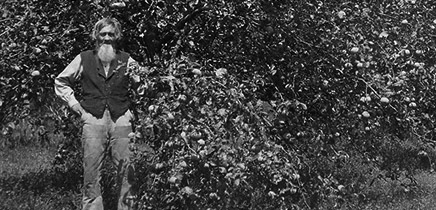The story of Waconia Sorghum is a story of the entrepreneurial spirit of American pioneers. It is the story of a trade passed from father to son. These are the facts of the Wessale family and their success in the sorghum industry.
John “Honza” and Catherine Wessale journeyed from Czechoslovakia to America in 1854. They eventually settled on a farmstead just south of Waconia, Minnesota. The couple would have 8 children, 2 of whom died in infancy. In 1864, when his oldest son was just 13, John “Honza” Wessale enlisted in the Civil War, walking from Waconia to enlist at Fort Snelling on January 18, 1864. Just over 5 months later, John Wessale died in Arkansas on July 5, 1864.
Catherine Wessale relied on the money sent home before her husband’s death, her widows pay, and the money her oldest son, John Jr., could provide through work, until her death in February 1916 at age 91. Over the years, John ran the farm and did odd jobs. Then, in the early 1880’s, John Wessale started growing sorghum and making syrup. He opened a sorghum mill in Waconia in 1901. It was in 1914 when poor health forced him to hand control to his sons that the sorghum mill really flourished and expanded. Control passed to sons Frank and Edward first, who had learned from their father since the ages of 9 and 10. Their brother George would join them after completing an engineering degree to aid in mechanizing and expanding the plant. Their brothers went into the paper business with their uncle, Anton Wessale, who would gain business success through ownership and publication of the Waconia Patriot and the St. Boni Star. John Wessale passed away February 6, 1920.
The Waconia mill was located on 3rd St., between Orange and Oak Streets. The plant was destroyed in the 1904 cyclone and later rebuilt. In the 1920’s, Edward Wessale designed and patented machinery to better remove the leaves and seeds from the stalks. The brothers also installed new machinery that extracted more syrup from the stalks. Waconia sorghum Mills, Inc. developed a new strain of the Minnesota Amber sorghum as well, which ripened earlier, kept longer after harvest, had greater weight, and had a higher juice content. By 1920, the company was producing 60,000 gallons of syrup a year. They were featured in papers, magazines and periodicals across the country.
In 1924, the brothers expanded the company into Cedar Rapids, Iowa. The plant there was nearly double the size of the Waconia plant. By 1928, the Waconia plant grew 550 acres of sorghum, the Cedar Rapids plant grew 1,750 acres. By 1929, the newspaper touted Waconia Sorghum as the largest mill in the world. That same year, the company expanded again into South Fort Smith, Arkansas. In 1933, the Waconia mill was put up for sale, and business continued only at the other locations. Over the years, those plants declined as well. Today, Waconia Pure sorghum is only part of our memories and history.
So what is sorghum? Sorghum is a grass plant that grows best in warm climates and reaches 2-8 feet in height. It is available in grain, grass and sweet types. It is grown around the world to make flour, porridge, syrup, malted and distilled beverages, feed for livestock, and ethanol. In the 21st century, the majority of sorghum grown in the U.S. is of the grain variety as livestock feed. It is seeing an increase through its use by ethanol plants. It is also a good alternative for those needing gluten-free foods.
In the late 19th and early 20th century, most sorghum grown was of the sweet variety. Crushing the stalks releases a juice that is then boiled down into a syrup. This syrup was often used in place of honey or molasses, not being as sweet as maple syrup. It was used as a sweetener in baking and cooking, and a spread or syrup on things like toast or pancakes. Sorghum syrup is still available in stores today, on shelves near molasses.
“Dreams of Lifetime Realized in the Sorghum Industry.” Waconia Patriot, December 30, 1926.
“Founder of Waconia Sorghum Mills Buried.” St. Bonifacius Star, February 13, 1920.
Kadlec, Tony. “Pavučina Corner, Guest Column: The Story of John Wessale.” Silver Lake Leader, June 16, 2011.
“Local Happenings.” Carver County News, May 2, 1929.
National Academy of Science. “Investigations of the scientific and Economic Relations Of. . .The Sorghum Sugar Industry.” Academic paper, November 1882. Washington, D.C.: Gov. Printing Office, 1883.
“Obituaries: John O. Wessale.” Washington Post online, January 15, 2005. Accessed August 7, 2014. http://www.washingtonpost.com/wp-dyn/articles/A11008-2005Jan14.html
“Sorghum Mills Product Well Known.” Weekly Valley Herald, March 22, 1928.
U.S. Department of Agriculture. “The Culture and Use of Sorghums for Forage.” Farmers Bulletin, no. 1844 (1955). Washington D.C.: U.S. Gov Printing Office, 1955.
Verne, W.W. “Verne’s Views.” Weekly Valley Herald, September 30, 1926.
Wessale, William. “Salutatory.” St. Bonifacius Star, June 6, 1919.


